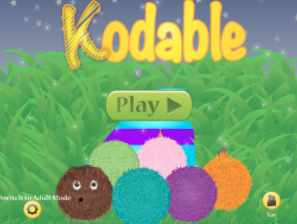
Kodable Language - Sequence

Overview
Students will learn about sequence and algorithms and use code to direct classmates during a fun game that gets the class moving!
What is Kodable? Kodable is a complete K-5 curriculum taking students from learning to think like a programmer in Kindergarten to writing real JavaScript by 5th grade. Kodable’s curriculum is aligned to K-5 standards which are a roadmap for developing the whole student through computer science. Kodable provides easy to follow lesson plans focused on student outcomes so teachers can teach their students to code, no computer science knowledge required.
For Kindergarten, the introductory lesson will be used. Kodable is not free, but the introductory lesson is FREE. It is a good introduction to coding.
Learning Objectives
Students will:
- Be able to explain what a programmer does.
- Be able to move a robot forward, spin, and jump using basic programming language.
Vocabulary
Vocabulary Words:
-
Programmer: A programmer is a person that writes the code (language) that tells the computer what to do.
-
Code: Code is the language that programmers use and create to tell computers what to do.
-
Sequence: Sequence is one of three basic flow control structures in programming, and is the very first concept a student must understand when learning to code. Also known as order of events, a computer will execute commands exactly in the order or sequence they are written. As a programmer, it is important to make sure that the commands given to a computer are in the right sequence, otherwise, a program might not run as expected.
Pre-planning
To prepare for this lesson:
-
The teacher needs to sign in or create an account at Kodable.
-
View the Classroom Setup Guide.
-
Use Google to sign in/create an account, or use your school email account.
- Follow the steps for a teacher
- Click My Classes
- Find your school
- Add My First Class (Recommended import from Google Classroom
- Name class > Pick Grade
- Add students
- Class code (Recommended make own - use name and room number or name and year)
- Follow the on-screen directions to add your first lesson Unit 1 > Introduction.
- Click Introduction and follow the steps.
Accommodations
See the Accommodations Page and Charts on the 21things4students website in the Teacher Resources.
Steps
Directions for this activity:
- The teacher will give the student directions on how to use Kodable.
- The teacher will have the students go to kodable.com or open the app.
- The students will join a class as a student by entering their teacher's code.
- The teacher will ask the students to have eyes up and listen for instructions.
- The teacher will direct them through the very helpful step-by-step instructions inside Kodable.com for the Introduction Lesson.
Note: There is a fee for more lessons. The basics are all you need for students at this level. Next step would be code.org which is free.
Assessment Options
Different options for assessing the students:
- Observations
- Check for understanding
Ask the class each question. Give 30 seconds for students to think and then turn to share with their partner for one minute (Think, Pair, Share). Record answers on chart paper to hang for later reference. Review programmer, programming language, and sequence.
- What is a programmer?
- What is an example of a program?
- How do computers or computer programs work?
- What happens if we give the computer directions in the wrong order? Who is smarter, computers or people?
These could be questions one puts inside Kahoot, Google Forms, or Google Classroom.
MITECS Competencies & ISTE Standards
MITECS: Michigan adopted the "ISTE Standards for Students" called MITECS (Michigan Integrated Technology Competencies for Students) in 2018.
Computational Thinker
5a. Students formulate problem definitions suited for technology-assisted methods such as data analysis, abstract models and algorithmic thinking in exploring and finding solutions.
5b. Students collect data or identify relevant data sets, use digital tools to analyze them, and represent data in various ways to facilitate problem-solving and decision-making.
5c. Students break problems into component parts, extract key information, and develop descriptive models to understand complex systems or facilitate problem-solving.
5d. Students understand how automation works and use algorithmic thinking to develop a sequence of steps to create and test automated solutions.
Devices and Resources
Device: PC, Chromebook, Mac, iPad
Browser: Chrome, Safari, Firefox, Edge, ALL
App, Extension, or Add-on:
Kodable iOS
CONTENT AREA RESOURCES
ELA
See Kodable > Kindergarten > More lessons.
Integrated Arts
See Kodable > Kindergarten > lessons
Math
You can instruct the “robot” ahead of time to do a complete turn instead of half a turn. When the robot does the turn incorrectly, open up a discussion about doing a ½ turn rather than a whole turn. You can make connections to fractions, positions on a clock, or degrees of rotation. Be sure to make the change in your code by adding, “1/2 turn” next to your spin command.
Science
See Kodable > Kindergarten > Science lessons
Social Studies
See Kodable > Kindergarten > S.S lessons
CREDITS
This task card was created by Jeremie Coplin, Kalamazoo RESA, February 2018. Updated October 2023.


